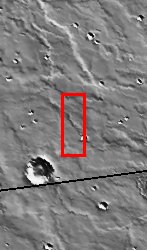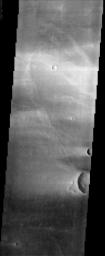- Original Caption Released with Image:
-

(Released 1 May 2002)
The Science
This image is from the region of Syrtis Major, which is dominated by a low-relief shield volcano. This area is believed to be an area of vigorous aeolian activity with strong winds in the east-west direction. The effects of these winds are observed as relatively bright streaks across the image, extending from topographic features such as craters. The brighter surface material probably indicates a smaller relative particle size in these areas, as finer particles have a higher albedo. The bright streaks seen off of craters are believed to have formed during dust storms. A raised crater rim can cause a reduction in the wind velocity directly behind it, which results in finer particles being preferentially deposited in this location. In the top half of the image, there is a large bright streak that crosses the entire image. There is no obvious topographic obstacle, therefore it is unclear whether it was formed in the same manner as described above. This image is located northwest of Nili Patera, a large caldera in Syrtis Major. Different flows from the caldera eruptions can be recognized as raised ridges, representing the edge of a flow lobe.
The Story
In the 17th century, Holland was in its Golden Age, a time of cultural greatness and immense political and economic influence in the world. In that time, lived a inquisitive person named Christian Huygens. As a boy, he loved to draw and to figure out problems in mathematics. As a man, he used these talents to make the first detailed drawings of the Martian surface - - only 50 years or so after Galileo first turned his telescope on Mars.
Mars suddenly became something other than a small red dot in the sky. One of the drawings Huygens made was of a dark marking on the red planet's surface named Syrtis Major. Almost 350 years later, here we are with an orbiter that can show us this place in detail. Exploration lives!
It's great we can study this area up close. In earlier periods of history, scientists were fascinated with Syrtis Major because this dark region varied so much through the seasons and years. Some people thought it might be a changing sea, and others thought it might be vegetation. Early spacecraft like Mariner and Viking revealed for the first time that the changes were caused by the wind blowing dust and sand across the surface.
What we can see in this image is exactly that: evidence of a lot of wind action. Bright dust patches streak across this image, formed through wind interference from craters and other landforms. These wispy, bright streaks are spread on the surface by a vigorous, east-west wind that kicked up huge dust storms, scattering the fine particles of sand and dust in an almost etherial pattern. The bright streaks in the top part of the image might have formed in a slightly different way, because there is no landform standing in the wind's way.
Beneath the bright surface dust are raised ridges that mark the edges of earlier lava flows from Nili Patera, a Martian "caldera." A caldera is a collapsed, bowl-shaped depression at the top of a volcano cone.
Can you imagine how Christian Huygens would feel if he lived today and could see all of this knowledge unfold? Or how it would feel to be the first person to stand in this dark volcanic and cratered region, knowing how many discovers had paved the way to that moment? Yes, exploration lives!
- Image Credit:
-
NASA/JPL/Arizona State University
Image Addition Date: -
2002-05-23
|

 Planetary Data System
Planetary Data System













